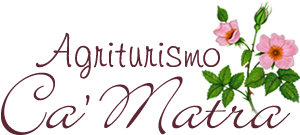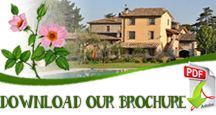
Cultural and sightseeing itineraries
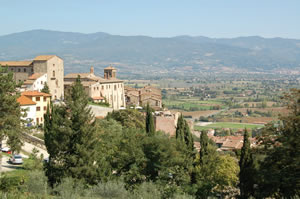 The High Tiber Valley is an area that covers southern Tuscany and the northernmost part of Umbria. Its history, nature and traditions have given life to a unique and well-preserved environment.
The High Tiber Valley is an area that covers southern Tuscany and the northernmost part of Umbria. Its history, nature and traditions have given life to a unique and well-preserved environment.
The tourists that choose to spend their time in the High Tiber Valley have the opportunity to visit castles, hermitages, old parish churches, medieval towns and artistically rich cities all surrounded by nature and scattered in various spots of the valley, which is crossed by the Tiber River and embraced by the hills.
UMBRIA
When in Umbria, you'll find yourself in an atmosphere of harmony. Every spot, every town, has a unique identity, the result of the legacy of the ancient civilizations that used to dwell in this area: Umbrians, Etruscans and Romans.
In time, farmers claimed the land and began cultivating olive trees and vineyards which generated exquisite products and became the symbol of the area.
When in Umbria, you need only travel a few kilometres to find yourself immersed in the wild of nature: beech woods, caves, brooks, springs, rivers that carve gorges, flowing slowly like the Tiber River and then the cascade of the Marmore Falls. You'll find that magical environment that inspired many poets and writers. Coming into contact with this land is an unforgettable experience.
HIGH TIBER VALLEY
The flow of the Tiber River enters the High Tiber Valley that lies between between Umbria and Tuscany, and is enclosed by the colourful Apennine hills all the way from Sansepolcro to Umbertid which depict what looks like a fresco by Piero della Francesca. Castles, abbeys, old parish churches and medieval towns rich in traditions and history rest on the hills and invite tourists to get to know this land which offers an old fashion type of hospitality in addition to its natural beauty.
The High Tiber Valley stretches for 50 kilometres, from Sansepolcro to Umbertide. The area covers southern Tuscany and the northernmost part of Umbria which also shares a border with Marche. The Tiber River crosses the entire valley making it a particularly fertile and verdant land.
In the fields, wheat, beets, hay and tobacco are farmed. The mountains are covered with oak, beech and chestnut trees; some rare firs stand out among them, while the cypresses, green and melancholic trees of Umbria and Tuscany, create an atmosphere of tranquillity that is difficult to find in any other place.
Unique, picturesque towns such as Citerna and Monte Santa Maria Tiberina rest on the hills of the High Tiber Valley, and others, such as Città di Castello, San Giustino, Montone, Umbertide, Lisciano Niccone and Pietralunga, can be found on the plains of the valley.
Farmhouses can be found all over the countryside, as if they were guardians of the fields along with the ruins of castles and towers that remind us of the past. This part of Umbria deserves particular attention, thanks to the medieval towns, churches, abbeys and castles, as well as to its healthy climate and ecological balance. This land is well-preserved and retains the traditions of the past; here, faith and history blend together in harmony, making this a very liveable land.
The industriousness of the people of this land is best represented by its handcrafted products: its old fashion like furniture, pottery, prints, ironworks and gold products make it famous worldwide. Moreover, the area features many antique shops where anything, from the smallest object to the most precious piece of furniture, can be found.
The restaurants and trattorias of the area are often located in old, characteristic buildings, and offer, in addition to local and traditional dishes, the unique liveliness of the Tuscan people, balanced by the quietness typical of Umbrians.
Places to visit
Città di Castello
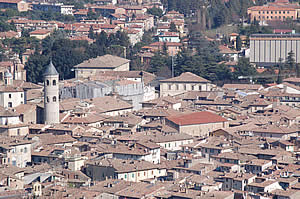 Città di Castello is the most important town of the area, thanks to its art and economic development; its past is recalled by the many medieval monuments and works of art from the renaissance.
Città di Castello is the most important town of the area, thanks to its art and economic development; its past is recalled by the many medieval monuments and works of art from the renaissance.
Città di Castello was at first an independent town which later became a flourishing Roman city, with the name of Tifernum Tiberinum. It was then destroyed by Totila (king of the Ostrogoths) and, according to legend, rebuilt by St. Florido, who is now patron-saint of the town. After the Longobardic domination, it became a medieval commune; it was ruled, in different periods, by Perugia, Florence and Vatican City. During the second half of the 15th Century, it was home to the Vitelli family. Thanks to this family, many beautiful buildings were constructed and many artists came to the city to work during that period.
Città di Castello was officially declared free in 1860, after the Piedmontese troops conquered it.
The old city centre is surrounded by the old city walls. Here, tourists will be able to enjoy all the points of interest the city has to offer:
- - The Cathedral. Its construction began during the renaissance, and the building was consecrated in 1540. The facade overlooking the enclosed garden has never been finished, while the other walls feature diverse stylistic elements: the portal is gothic, whereas the staircase is from the 18th Century. The inside dates back to the 16th Century, while the dome and coffered ceiling are from the 18th Century. The Cathedral features an underground church, where the remains and the tomb of St. Florido are found. Beside the main door is the entrance to the museum of the Cathedral where many works of art and precious hand-crafted gold products can be admired.
- - Palazzo dei Priori. This building is now the town hall, and it is one of the most beautiful buildings in Umbria. It is located right in front of the belfry, that used to be the symbol of the power of the Commune, back in the 14th Century.
- - Cylindrical bell tower. This tower is all that remains of the old Romanic structure of the 3rd Century.
- - City belfry, dating back to the 14th Century.
- - San Domenico (St. Dominic). This church was built by Dominican monks in 1271. Its walls are decorated by Umbrian frescos.
- - San Francesco (St. Francis). This church was consecrated in 1291; it features the Vitelli chapel, built by Giorgio Vasari. Inside, it is decorated by beautiful choir stalls. It is not certain whether they were built according to models by Raffaello Sanzio who, in his youth, painted one of his masterpieces "Lo sposalizio della Vergine" (The Marriage of the Virgin) in this church.
- - Santa Maria Maggiore and Madonna delle Grazie. Two beautiful buildings from the 15th Century.
- - Thermal baths of Fontecchio. Since the Roman era, people have been coming to these thermal baths to treat hepatic diseases, skin diseases and arthrosis.
- - Town gallery. It is located inside Palazzo Vitelli Alla Cannoniera. It features many works of art by artists from the Sienese school, Luca Signorelli and Raffaello Sanzio.
- - Chapter Musem. This museum was completely renovated. It features works of sacred art, and a unique collection of trays used for religious rituals that were found inside the sanctuary of Canoscio.
- - Burri museum. It is situated inside the old tobacco drying kiln in the Rignaldelloi neighbourhood.
- - Burri collection. It is situated inside the Albizzini building, overlooking Garibaldi square.
- - Town library. The town library contains the paleontological and archaeological sections of the regional district.
- - Center of traditions – Garavelle. This collection regards craftsmanships, the farming culture and Railway modelling.
EVENTS:
- Festival delle Nazioni. Held in August-September, the Festival delle Nazioni (Festival of Nations) is a festival dedicated to chamber music. During the festival, you have the opportunity of participating in high-level music courses.
- Mostra Nazionale del Mobile in Stile. Held in September, the Mostra Nazionale del Mobile in Stile is an exhibit of furniture built according to different historic styles.
- Fiera delle Utopie Concrete. The Fiera delle Utopie Concrete (Fair of Concrete Utopias) is held in October.
- Tiferno Blues Festival. The Tiferno Blues Festival is held in July.
- Rievocazione delle Feste Floridiane. Held in August, the Rievocazione delle Feste Floridiane is a fair held every year.
- Palio dell'Oca. Held in October, the Palio dell'Oca (the Goose Race) is a historical re-enactment.
- Canoeing in the Tiber. In March, it is possible to canoe in the Tiber.
- Canoeing in the Tiber to Rome. In April, it is possible to reach Rome by canoeing in the Tiber.
- Retrò. Held on the third Sunday of every month, Retrò is a market where anything from antiques to handcrafted objects can be found.
- Mostra Nazionale del Cavallo. Held during the second week of September, the Mostra Nazionale del Cavallo is a horse exhibition. www.mostradelcavallo.com
- Mostra Mercato del Tartufo Bianco e dei Prodotti del Bosco. Held on the first Sunday of November, the Mostra Mercato del Tartufo Bianco e dei Prodotti del Bosco is a fair dedicated to truffles (especially white truffles) and mushrooms. www.iltartufobianco.it
Anghiari
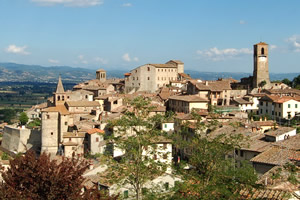 Anghiari is a bautiful Tuscan town nestled on one of the hills that enclose the High Tiber Valley on its west side. All of Anghiari's medieval features are intact; in the year 1500 a wall was built around the town, and a steep road was created to reach it. The town square is enclosed by beautifully designed buildings.
Anghiari is a bautiful Tuscan town nestled on one of the hills that enclose the High Tiber Valley on its west side. All of Anghiari's medieval features are intact; in the year 1500 a wall was built around the town, and a steep road was created to reach it. The town square is enclosed by beautifully designed buildings.
Anghiari has been ranked among the 100 most beautiful medieval towns in Italy. The town is surely worth a careful visit, it is surprisingly beautiful and ideal to take a walk. Strolling along the alleys, in the bastion and the small squares of the old town centre, you will have the chance to admire charming sights and will start to feel as if you had gone back in time.
Walking through the town, will make you feel like you are part of a watercolour painting, far away from the hectic modern pace of life. A visit to Anghiari will surely turn into a hunt for its most beautiful niches, and your eyes will be delighted by how time seems to have stopped in this town.
Walking through Anghiari, you will hear a hammer beating on the anvil, a saw cutting the wood, hands weaving threads and wicker. Here, master artisans work with passion in their workshops, keeping the traditions of the place alive. The cusne in Anghiari respects its origins so it is simple and cooked using excellent fresh seasonal ingredients.
The town is famous for the Battle of Anghiari, fought on June 29th 1440, when the troops of Filippo Maria Visconti, the duke of Milan, faced the armies of the Papal States and Florence. The troops of thelatter won the battle, and Milan's army commander, Nicola Piccinino, fled. Leonardo Da Vinci painted a fresco of the battle on the walls of Palazzo Vecchio in Florence but it was later covered by another fresco by Giorgio Vasari.
MUSEUMS
- Museo Statale di Palazzo Taglieschi (Palazzo Taglieschi State Museum)
- Palazzo della Battaglia – museo delle memorie e del paesaggio nella terra di Anghiari (Palace of the Battle – Museum of the memories and landscape of Anghiari)
- Museo della Misericordia (Museum of the Mercy)
PARKS
- Parco dei Monti Rognosi e della valle del Sovara (Nature Park of Mount Rognosi and the Sovara Valley) – Located north of Anghiari, it can be reached by taking SP45 (provincial road #45) heading towards Ponte alla Piera.
- La fabbrica della Natura (The factory of Nature) – Visitors center of the Nature Park of Mount Rognosi and the center of environmental education.
EVENTS
- Palio della Vittoria. Held on June 29th, the Palio della Vittoria (Race of Victory) is a running competition.
- Mostra Mercato dell'Artigianato della Valtiberina Toscana. Held in April/May, the Mostra Mercato dell'Artigianato della Valtiberina Toscana is a fair where local handcrafted products can be found.
- Theatre and music seasons. November-April
- Anghiari Festival. Every July, the Southbank Sinfonia (https://southbanksinfonia.co.uk/) moves to Anghiari for a week to delight the citizens of the town and the tourists with its music.
- Tovaglia a Quadri. Held in august, Tovaglia a Quadri (Chequered Tablecloth) is a theatre festival for local companies. During the plays, at the end of each act, the audience will be served local dishes.
- Festival dell'Autobiografia. Held in September, the Festival dell'Autobiografia is a festival dedicated to autobiographies.
- I Centogusti dell'Appennino. Held in October/November, I Centogusti dell'Appennino is a fair dedicated to agro tourism and local food.
Citerna
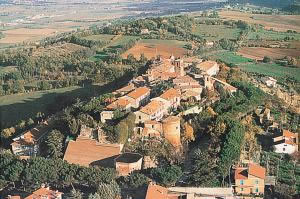 Citerna is a medieval town located 480m above sea levelon a hill, easily recognisable from the sky by the unique outline of its walls. The town was previously called Monte Albano, but its name was changed to Citerna during the 10th Century, when the castle was built. Its particular structure makes it unique among the towns of central Italy because it is built on two levels: the town is on the top of the hill, and underground, beneath the perimeter of the walls, are the medieval roads.
Citerna is a medieval town located 480m above sea levelon a hill, easily recognisable from the sky by the unique outline of its walls. The town was previously called Monte Albano, but its name was changed to Citerna during the 10th Century, when the castle was built. Its particular structure makes it unique among the towns of central Italy because it is built on two levels: the town is on the top of the hill, and underground, beneath the perimeter of the walls, are the medieval roads.
The square of this small town overlooks the valley, and it is one of the best spots to admire its beauty. Despite the low altitude of the place, by stopping here you will have the chance to admire the unspoiled beauty of the High Tiber Valley all the way from Città di Castello to Sansepolcro, from Mount Penna, where the Sanctuary of La Verna is located, to Mount Catria. The people who ruled over this land throughout history, from the Etruscans and the Lombards to the Republic of Florence and the Papal States, all contributed in making this little town a charming place immersed in an incredible atmosphere.
By simply walking down the central street of the town you'll feel like being back in time. This street leads to the top of the town, where the castle, and the home of the governors (the Da Citerna and Da Montauto families), used to be. The ruins of the castle are a charming view, and the remaining walls testify the old majesty of the building.
v
The town is made even more captivating by the medieval underground roads, that run underneath most of the perimeter of the old walls.
Points of interest:
- - The round tower. The round tower is the symbol of the town.
- - The castle. The castle is the oldest part of the town: it dates back to the times when the Lombards ruled the land
- - The old well. The old well is thought to have been part of the cistern located underneath the building that today is the town hall.
- - The church of St. Michael the Archangel. This church has a simple facade, but some precious works of art are found in it, most notably the Crucifixion by Pomarancio.
- - The town hall, the city belfry and the Bontempelli theatre, small yet beautiful, recently renovated.
- - Church of St. Francis. This church, dating back to the 6th Century, was part of the Franciscan convent that was later bought by the council, that today uses it as the town hall. The church is spacious and bright and has the shape of a Latin cross. It has nine altars decorated with golden reliefs, and it could almost be considered a museum thanks to the precious works of art that are found in it: the Virgin and Child by Donatello, the Virgin and Child by Luca della Robbia, a Fresco by Luca Signorelli, various paintings by Raffaellino del Colle and the Deposition by Pomarancio.
EVENTS
- Il Torrione. Held on various days from March to June, Il Torrione (The Tower) is a theatre festival dedicated to dialectal comedy.
- E se le donne... E se le donne (What if women...) is a festival about the feminine world. It is held on various days from March to June.
- Citerna Fotografia. Citerna Fotografia (Citerna Photography) is a photography festival held from April to May.
- La Bisaccia del tarufaio – Sapori e Saperi dell'Alta Valle del Tevere. La Bisaccia del tarufaio – Sapori e Saperi dell'Alta Valle del Tevere (The Pannier of the Truffle Hunter – Flavors and Knowledge of the High Tiber Valley) is a fair dedicated to local food. It is held on the second weekend of October.
- Masterclass of Music. Masterclass of Music is a music festival held in July. The festival, in addition to the concerts, offers the chance to participate in music lessons given by important musicians from all around the world.
Important personalities from the High Tiber Valley
- - Piero della Francesca: Sansepolcro, Monterchi, Arezzo.
- - Alberto Burri: Città di Castello.
- - Luca Pacioli: Sansepolcro.
- - Michelangelo Buonarroti: Caprese Michelangelo.
Art Itineraries
- Medieval towns (within 15-20 km from the Ca'Matra farmhouse): Sansepolcro, Città di Castello, Citerna, Montone, Monterchi, Anghiari, Monte Santa Maria Tiberina.
- Castles and parish churches: Bufalini Castle in San Giustino, the Castles of Lippiano and Monte Santa Maria Tiberina, the Castle of Montauto, the Castle of Galbino, the Castle of Montecchio, Pieve di Santa Maria alla Sovara (Parish Church of St. Mary by the creek Sovara), Abbadia d'Uselle (Abbey of Uselle).
- Cities of Art: Arezzo, Cortona, Perugia, Gubbio, Assisi, Spello, Deruta, Firenze, Siena.
- Points of religious interest: Monte Casale, La Verna, Camaldoli.
- Naturalistic itineraries: Alpe della Luna (Moon Alps), Lake Montedoglio, Lake Trasimeno.
Offerte Speciali
- Discover our Ca' Matra Wines
The Ca' Matra Farm House, located in "Alta Valle del Tevere", mainly cultivates&...
